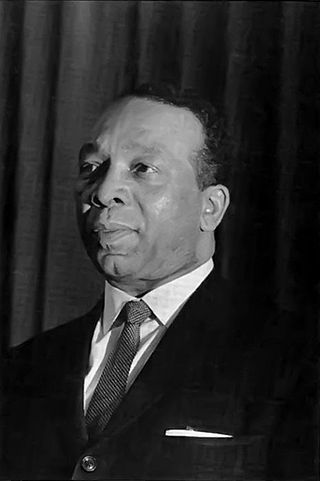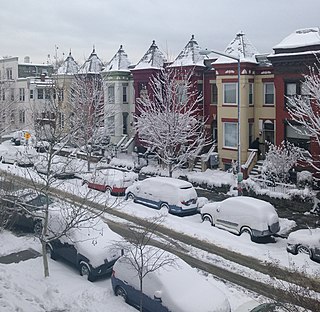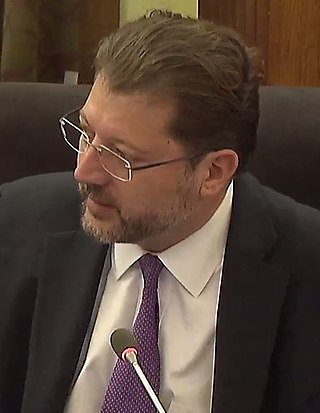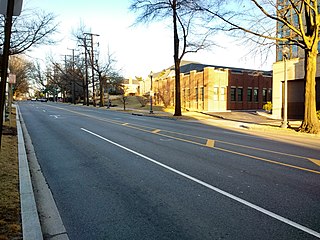Related Research Articles

Washington, D.C., formally the District of Columbia and commonly called Washington or D.C., is the capital city and the federal district of the United States. The city is located on the east bank of the Potomac River, which forms its southwestern border with Virginia and borders Maryland to its north and east. Washington, D.C. was named for George Washington, a Founding Father, victorious commanding general of the Continental Army in the American Revolutionary War and the first president of the United States, who is widely considered the "Father of his country". The district is named for Columbia, the female personification of the nation.

Walter Edward Washington was an American civil servant and politician. After a career in public housing, Washington was the chief executive of the District of Columbia from 1967 to 1979, serving as the first and only Mayor-Commissioner of the District of Columbia from 1967 to 1974, and as the first Mayor of the District of Columbia from 1975 to 1979.

Swampoodle was a neighborhood in Washington, D.C. on the border of Northwest and Northeast in the second half of 19th and early 20th century. This neighborhood is no longer known as Swampoodle and has been replaced in large part by NoMa.

Shaw is a neighborhood of Washington, D.C., located in the Northwest quadrant. Shaw is a major entertainment and retail hub, and much of the neighborhood is designated as a historic district, including the smaller Blagden Alley-Naylor Court Historic District. Shaw and the U Street Corridor have historically have been the city's hub for African-American social, cultural, and economic life.

Bloomingdale is a neighborhood in the Northwest quadrant of Washington, D.C., less than two miles (3 km) north of the United States Capitol building. It is a primarily residential neighborhood, with a small commercial center near the intersection of Rhode Island Avenue and First Street NW featuring bars, restaurants, and food markets.

Philip Heath Mendelson is an American politician from Washington, D.C. He is currently Chairman of the Council of the District of Columbia, elected by the Council on June 13, 2012, following the resignation of Kwame R. Brown. He was elected to serve the remainder of Brown's term in a citywide special election on November 6, 2012, and re-elected to a full term in 2014 and 2018.

Petworth is a residential neighborhood in the Northwest quadrant of Washington, D.C. It is bounded to the east by the Armed Forces Retirement Home and Rock Creek Cemetery, to the west by Arkansas Avenue NW, to the south by Rock Creek Church Road NW and Spring Road NW, and to the north by Kennedy Street NW.

Streetcars in Washington, D.C. transported people across the city and region from 1862 until 1962.

Florida Avenue is a major street in Washington, D.C. It was originally named Boundary Street, because it formed the northern boundary of the Federal City under the 1791 L'Enfant Plan. With the growth of the city beyond its original borders, Boundary Street was renamed Florida Avenue in 1890.
The streets and highways of Washington, D.C., form the core of the surface transportation infrastructure in Washington, D.C., the federal capital of the United States. Given that it is a planned city, the city's streets follow a distinctive layout and addressing scheme. There are 1,500 miles (2,400 km) of public roads in the city, of which 1,392 miles (2,240 km) are owned and maintained by city government.

The attorney general for the District of Columbia is the chief legal officer of the District of Columbia. While attorneys general previously were appointed by the mayor, District of Columbia voters approved a charter amendment in 2010 that made the office an elected position beginning in 2015.

David Grosso is an American attorney and politician. He is a former at-large member of the Council of the District of Columbia who lives in Brookland. A native Washingtonian, he graduated from Earlham College and Georgetown University Law Center. Grosso is a member of the D.C. Bar. Following the completion of his second term on the D.C. Council, he joined the law firm Arent Fox as a lobbyist.

Western Avenue is one of three boundary streets between Washington, D.C., and the state of Maryland. It follows a southwest-to-northeast line, beginning at Westmoreland Circle in the south and ending at Oregon Avenue NW in the north. It is roughly 3.5 miles (5.6 km) in length. First proposed in 1893, it was constructed somewhat fitfully from about 1900 to 1931.

The 2014 District of Columbia Attorney General election was held on November 4, 2014, to elect the Attorney General of Washington, D.C., concurrently with elections to the United States Senate in various states and elections to the United States House of Representatives, and various state and local elections.

The District of Columbia Jail or the D.C. Central Detention Facility is a jail run by the District of Columbia Department of Corrections in Washington, D.C., United States. The Stadium–Armory station serves the D.C. Jail. The majority of male inmates housed in the Central Detention Facility are awaiting adjudication of cases or are sentenced for misdemeanor offenses. Female inmates in the custody of the D.C. Department of Corrections are housed at the adjacent Correctional Treatment Facility. After the National Capital Revitalization and Self-Government Improvement Act of 1997, sentenced felons are transferred to the Federal Bureau of Prisons.

The Blagden Alley-Naylor Court Historic District is a neighborhood in the Shaw district of Washington, D.C., characterized by two alleyways, Blagden Alley and Naylor Court, bounded by 9th, 10th, M and O Sts., NW.

Black Lives Matter Plaza is a two-block-long pedestrian section of 16th Street NW in downtown Washington, D.C. The plaza was renamed by Mayor Muriel Bowser on June 5, 2020, after the Department of Public Works painted the words "Black Lives Matter" in yellow, 35-foot-tall (11 m) capital letters, along with the D.C. flag, during the series of George Floyd protests taking place in the city.

The Codman Carriage House and Stable is a historic building located at 1415 22nd Street NW in the Dupont Circle neighborhood of Washington, D.C. The industrial building was constructed in 1907 as a carriage house and stable for socialite and art collector Martha Catherine Codman, who lived a few blocks north in her home, later known as the Codman–Davis House. She commissioned her cousin, Ogden Codman Jr., an architect and prominent interior decorator who also designed her home. He designed it in a Second Empire style.

The 2012 United States Shadow Senator election in the District of Columbia took place on November 6, 2012, to elect a shadow member to the United States Senate to represent the District of Columbia. The member was only recognized by the District of Columbia and not officially sworn or seated by the United States Senate. Incumbent Michael D. Brown was re-elected to a second term.
The W.C. and A.N. Miller Companies are a group of related privately-held real estate firms known for developing residential communities in Washington, D.C. and its surrounding metropolitan area. Developers of neighborhoods including Spring Valley and Wesley Heights in D.C., Sumner in Bethesda, and Potomac Falls in Potomac, Maryland, they were considered to be one of Washington's most renowned realty developers in the early 20th century.
References
- 1 2 "D.C. Law Library - Chapter 17. Public Records Management" . Retrieved May 8, 2021.
- 1 2 3 Sewell Chan (December 4, 2003). "City's Records Center Compiles a History of Neglect". The Washington Post. Retrieved May 8, 2021.
- ↑ Rachel Kurzius (August 31, 2016). "The Lovings' Marriage License Is Now On Display At D.C. Court". DCist . Retrieved May 8, 2021.
- 1 2 Elissa Silverman (January 21, 2000). "Past Mistakes - Washington City Paper". Https. Retrieved May 8, 2021.
- ↑ Jacob Fenston (March 29, 2021). "Melvin Hazen Helped Segregate D.C., And Got A Park In His Name". DCist . Retrieved May 2, 2021.
- ↑ Linda Wheeler (April 18, 1988). "Horse Barn in NW To Be City Archives; Cleanup Jolts Naylor Court". The Washington Post.
- ↑ Linda Wheeler (March 21, 1991). "Little-Known Treasure: D.C. Archives Quietly Rounding Up Secrets of City's Past". The Washington Post.
- ↑ Linda Wheeler (January 16, 1997). "Is It History for D.C Archives?: As Its Founder Retires, Agency Dwindles to Two Employees; Cleanup Jolts Naylor Court". The Washington Post.